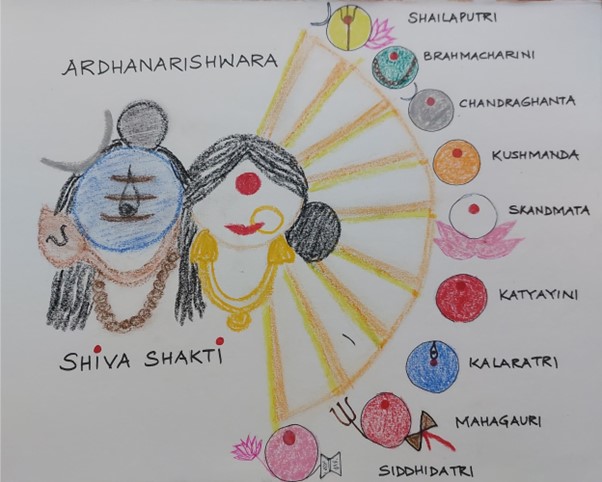‘Ardhanarishwara’, the deity symbolizes masculine and feminine in each human being irrespective of gender, embracing dualities of life.

SHIVA (or Purusha) symbolises consciousness, the masculine principle.
SHAKTI (or Prakriti) symbolises the feminine principle, the activating power and energy.
In simpler words, Shiva brings order and harmony to all of creation, a task that requires enormous amount of energy, with precision and grace. Durga provides Shiva with the energy as Shakti and the grace needed to use the vast, incalculable power for the benefit of creation. Their coming together provides purpose and sustenance to the universe.
Shiva and Shakti exist within each of us as the masculine and feminine principles complementing and balancing each other. It is not about the gender. It is the divine energy that we all possess irrespective of our gender. The feminine nourishes the soul, the masculine provides meaning. The feminine nurtures the masculine while the masculine creates safety for feminine to thrive. It is about holding both to become complete.
The patriarchal society has always emphasized on the masculine energy, underestimating the feminine which brings connectedness, belongingness, stillness, peace and creativity. The achievement and outcome oriented world (masculine) craves for peace and talks about stillness. Navaratri is a symbolic celebration of feminine in various forms.
Accessing and acknowledging the feminine within will leads to a more balanced, nourished and fulfilled world. In growing turmoil in all aspects of life, this has become important now more than ever.
The nine forms of Shakti worshipped over a period of 9 days symbolizes the feminine forms each of us carry:
SHAILAPUTRI symbolizes the mountain like will power and determination which provides grounding.
BRAHMACHARINI symbolizes grace, humility and detachment
CHANDRAGHANTA symbolizes courage and bravery
KUSHMANDA symbolizes creativity, resourcefulness, playful and ever learning
SKANDAMATA symbolizes the mother form full of emotional strength, empathy, love and compassion
KATYAYINI symbolizes the silent force with warrior like resilience
KALARATRI symbolizes the risk taker, the adventurer
MAHAGAURI symbolizes calm, composed, poised with ray of hope
SIDDHIDATRI symbolizes the healing power, well being and fullness of existence
The tenth day, VIJAYA DASHMI is marked as the day when the goodness triumphs over the evil. The evil within us can be won over not by fighting it but by forgiving it. The evil within us is a result of the unnoticed wound stored over the years. When they are acknowledged, noticed and listened to is when they heal and turn into goodness.
Today, I choose to forgive myself for all my evils and liberate them of the chains. When I forgive myself, I forgive others too and set the evils free of the misery. When I reclaim my Shakti within, my Wounds heal and I can bring forth healing to others.

